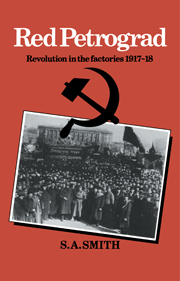Book contents
- Frontmatter
- Contents
- Acknowledgements
- Introduction
- 1 A profile of the Petrograd working class on the eve of 1917
- 2 The tsarist factory
- 3 The February Revolution: A new dispensation in the factories
- 4 The structure and functions of the factory committees
- 5 Trade unions and the betterment of wages
- 6 The theory and practice of workers' control of production
- 7 Deepening economic chaos and the intensification of workers' control
- 8 The social structure of the labour movement
- 9 The October Revolution and the organisation of industry
- 10 The economic crisis and the fate of workers' control: October 1917 to June 1918
- Conclusion
- Notes
- Bibliography
- Index
4 - The structure and functions of the factory committees
Published online by Cambridge University Press: 11 January 2010
- Frontmatter
- Contents
- Acknowledgements
- Introduction
- 1 A profile of the Petrograd working class on the eve of 1917
- 2 The tsarist factory
- 3 The February Revolution: A new dispensation in the factories
- 4 The structure and functions of the factory committees
- 5 Trade unions and the betterment of wages
- 6 The theory and practice of workers' control of production
- 7 Deepening economic chaos and the intensification of workers' control
- 8 The social structure of the labour movement
- 9 The October Revolution and the organisation of industry
- 10 The economic crisis and the fate of workers' control: October 1917 to June 1918
- Conclusion
- Notes
- Bibliography
- Index
Summary
THE STRUCTURE OF THE FACTORY COMMITTEES
The bigger a factory, the more likely it was to have a factory committee. The most comprehensive data on this question do not, at first sight, appear to bear out this contention, for if one groups the delegates to the First Conference of Petrograd Factory Committees (30 May-3 June), according to the size of the factory from which they came, it emerges that the biggest proportion of delegates came from medium-sized factories of 100–500 workers, rather than large ones. If, however, one compares the number of factories of a given size, represented at the conference, to the total number of factories of that size in Petrograd, then it becomes clear that a direct correlation exists between the size of an enterprise and the likelihood of its being represented. Thus 100% of factories with a workforce of more than 5,000 (18 in number) were represented at the First Conference, whereas less than 5% of factories with 50 workers or less were so. 200 workers seems to have been the critical size, for over half the factories of that size or larger sent delegates to the conference. In enterprises of less than 200 workers, it seems that workers were either less interested or less able to set up committees. There is evidence that, notwithstanding the fact that factory owners were obliged by law to recognise the committees, some small employers prevented their workers organising such committees. At the tiny Glazer leather workshop, the nineteen workers formed a committee in March, but its members were fired by the boss and, as a result, the committee collapsed.
- Type
- Chapter
- Information
- Red PetrogradRevolution in the Factories, 1917–1918, pp. 80 - 102Publisher: Cambridge University PressPrint publication year: 1983



